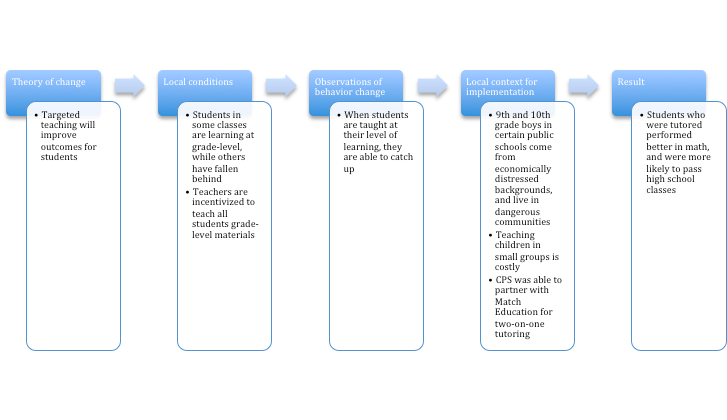Decide on a policy to implement based on local factors
To get the critical buy-in from leadership to implement a new policy or program, the project lead should schedule a meeting with decision makers to present the evidence surrounding the policy options captured in the template. Depending on your insight into your city leadership's willingness to make change, you may wish to share the research you have conducted on the root causes of the problem and some of your analysis on the impact of current efforts to date.
Consider the applicability of an approach
As discussed in the previous chapter, policymakers often look for evidence of effective programs in other cities, but often the question arises of how generalizable a program is from one city to another. The Abdul Latif Jameel Poverty Action Lab (J-PAL) suggests that in reviewing evidence from another location, it is helpful to identify the specific mechanism that was used (delivery of program or service, information sharing, etc.), identify the local conditions that were in place, observe the behavior change that resulted from the mechanism, and finally to understand local context and conditions (legal or cost constraints, cultural norms, etc.). This set of presentation elements can be drawn from the list of details collected in the research template.
| Education policymakers in Chicago, IL, used findings from programs in Kenya and India, in which children who had fallen behind their peers were given educational support targeted to their level of learning. The mechanism used was targeted teaching and there were similar conditions present in all three countries. Although some students had fallen behind in the curriculum, teachers were incentivized to teach grade-level materials. Considerations of how the local context in Chicago might affect implementation of a targeted teaching program included understanding how the neighborhoods that the students were from may have affected their educational outcomes and the high cost of teaching in small groups. In Chicago, Match Education provided two-on-one tutoring, which matched students with well-educated individuals who have not had formal teacher training for a lower-cost model. The results were positive. Students who were tutored performed better in math and were more likely to pass high school classes. |
|---|
The "generalizability framework" proposed by J-PAL is below. Use this as a template as you consider potential policy solutions.

Source: The Generalizability Puzzle
Once you have narrowed the policy options, discuss the questions below for each options you are considering. This step is critical, as understanding local context is so important in successful policy implementation.
Community Context Questionnaire
Local context:
- Does this option make sense in our community?
- Is this a "one size fits all" approach?
- Is any particular group absent from this approach?
- If so, is that ok?
| Your answers: |
|---|
Effectiveness:
- What would we expect to observe if the pilot is as effective here as in City X?
| Your answers: |
|---|
Timing:
- Does the timing make sense?
- Is this the right time to implement this policy change?
- Where are the potential roadblocks that could affect the schedule?
- Is there any way to mitigate this?
- How long would it take to see an impact?
| Your answers: |
|---|
Implementation:
- Do we have the staff capacity to implement this?
- Are there additional partners that you can bring to the table to support implementation?
- Does this make sense given our form of government?
| Your answers: |
|---|
Authority:
- Does our city have the authority to enact this?
- If so, what is the appropriate mechanism?
- Are there legal barriers?
- Are there any existing preemption issues from the state or federal government?
- Can those be addressed through legislation/advocacy?
- Is there political support or opposition to this?
| Your answers: |
|---|
Cost:
- How much will this cost annually?
- How will we pay for it?
- Can the policy be implemented with existing funding?
- If so, is this funding reliable?
- How would this policy option affect our city's budget in the short and long term?
- What other funding options can we consider?
- Is there an alternative that would cost less and give us similar results?
- Will any constituency be adversely affected if funding for programs that impact them is shifted to another program, policy, or initiative?
| Your answers: |
|---|